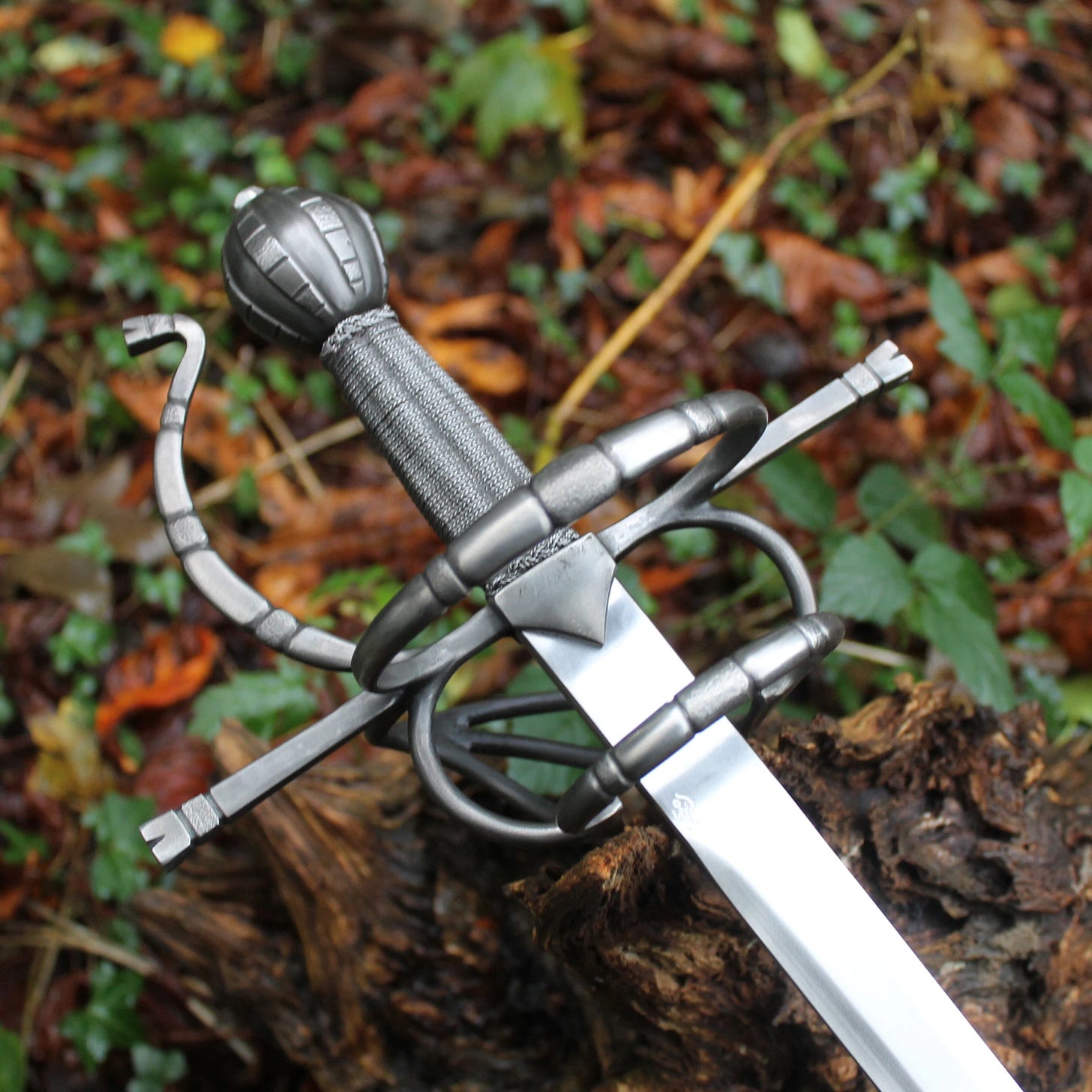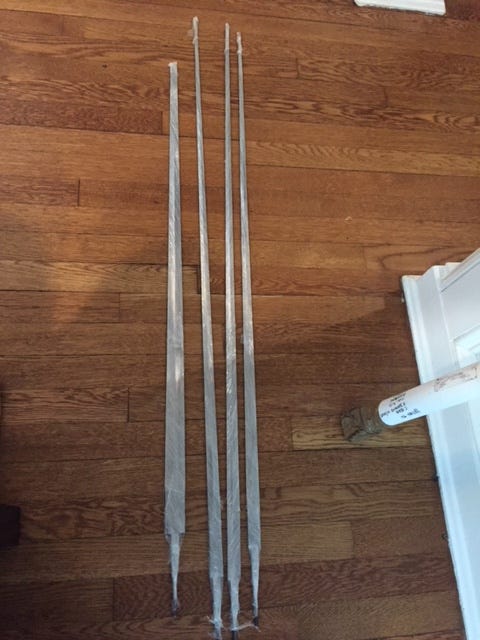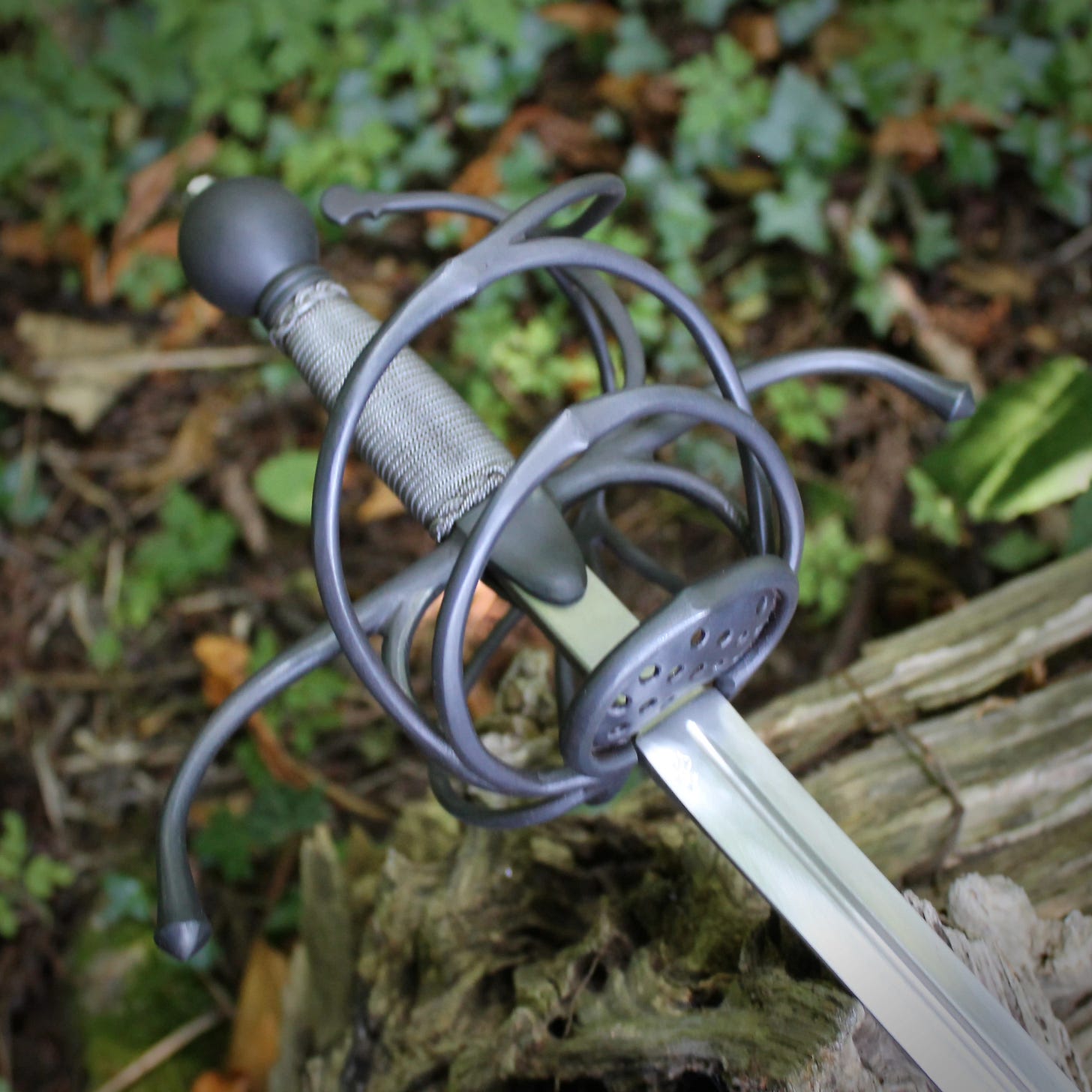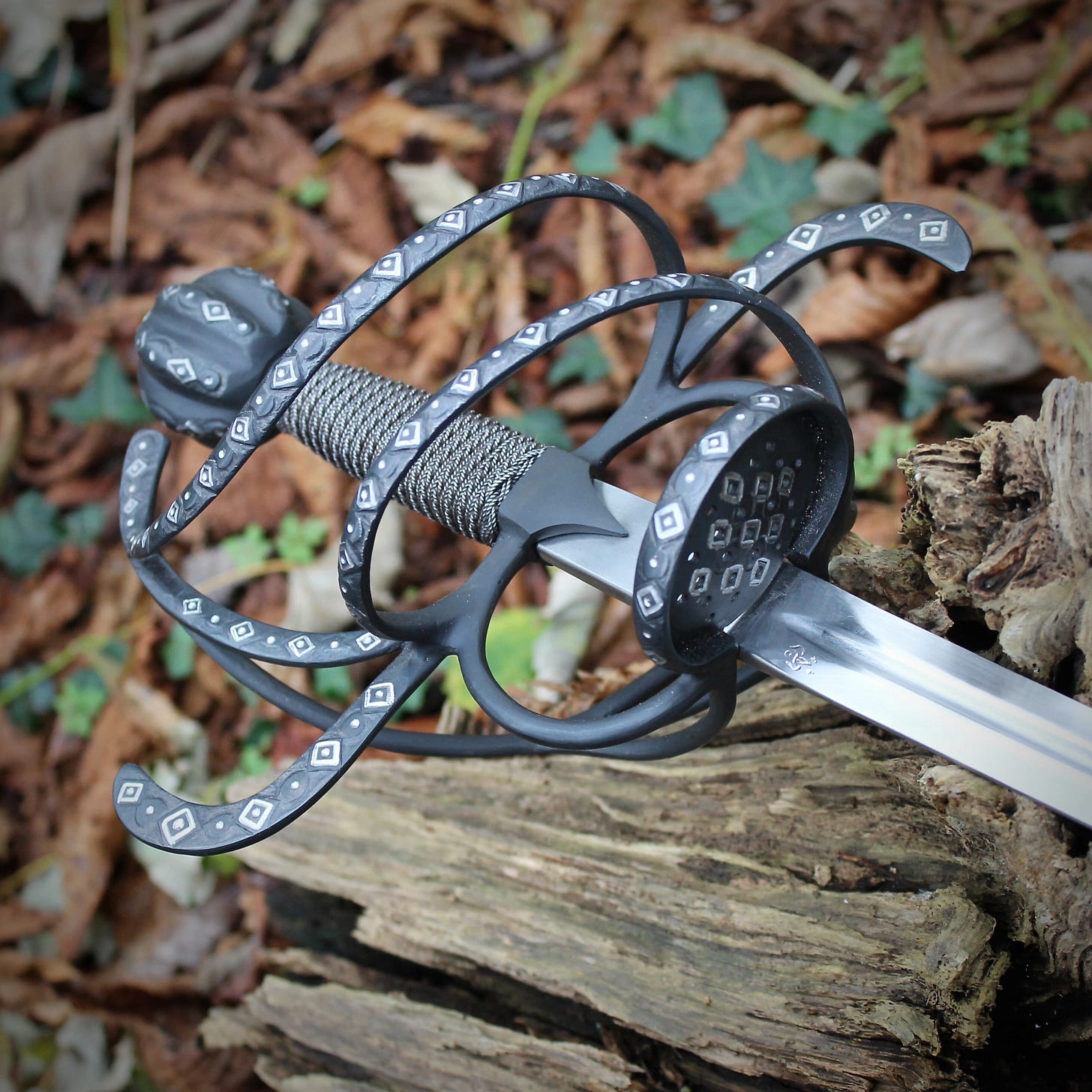Back in late 2017 or early 2018, when Marco Danelli announced he was stepping away from swordmaking due to ill health, his apprentice Chris Adams made the life-changing decision to set up his own forge and keep producing the blades he’d been making for Marco.
As I’ve mentioned before, I was enamored with their blade design and implementation, and immediately sent Chris a message that I wanted to buy a number of blades from him to fit my hilts. Effectively I was happy to give him some of the capital he needed to get set up, because I wanted to see those blades continue to be made (and to be made FOR ME in particular!).
So here I’ll detail a little bit what I like about their blades, give some stats on the ones I’ve purchased, and showcase a couple of the complete swords that Balefire Blades has produced. Though I have yet to commission a complete sword from them myself, I have inspired several fencers I train with and teach to do so and they are all very happy with their purchases.
Balefire Blades
Having discovered a passion for fencing at the Sussex Sword Academy, Chris began studying the art and alchemy of swordmaking under Marco Danelli in 2013. Upon graduating from his apprenticeship, he continued to craft fine blades at Danelli Armouries until 2017.
Chris founded Balefire Blades in 2018, and has since trained himself in the traditional crafts of hand-forging, forge welding and engraving with chisel and burin.
Combining extensive experience as a smith and fencer with an insatiable curiosity about traditional crafts, Chris takes pride in creating fencing-ready works of art.
Drawing inspiration from folklore, fantasy and astute observations of historical fencing and weaponry, Chris is dedicated to sharing that world with historical fencers around the world.
Alicia Adams is Chris’ partner in this endeavor. As the voice of the business, she is responsible for Balefire’s messaging and marketing, creating quality content across the website, social media, and our limited edition books.
Alicia also started studying leatherwork under Chris in 2019, and now creates handmade scabbards, sword belts and baldrics, and protective fencing gear.
Balefire’s blade design
So one of the problems that blade makers have to overcome when they are making blades for practice swords is how to make them relatively safe while still responding like a real, sharp blade. A practice rapier blade and sidesword blade should have a blunt edge and should flex more when thrust into a target than a real sharp blade that was meant to do real damage would.
I’ve seen a few different approaches to this:
Just make the edge blunt:
Curve the blade gradually, reducing the width toward the point so that there’s more steel closer to the hilt:
Design a wide forte and somewhat dramatic shoulder that turns into a steel bar so that more of the steel is close to the hilt:
Create effectively an I-beam design that tapers into a blunt bar:
Scallop the flat surfaces of the blade:
Each of these designs has pros and cons. But my preferred design is the one with the scalloped faces.
The scalloped design
If you simply create a blade that has the look of an original and give it blunted edges, It leaves a good amount of steel down the length of the blade compared to the blade it’s mimicking.
Here’s the cross section of a 6mm thick diamond cross-section blade that’s about 30mm wide:
Here’s the cross section of a 6mm thick blade that’s about 30mm wide with a 1mm edge:
They look pretty much alike, right? But here’s an overlay - the blunted blade is shown in red:
You can see that down the entire length of the blade, that’s a significant amount of steel added on to the sharp blade in order to make it safe for practice.
Now here’s how much steel you’re removing from that blunted design when you scallop the faces of the blade:
And for further comparison, here’s the scalloped blade (red dotted lines) overlayed on top of the sharp:
The extra steel that makes up the blunted edge is offset pretty well by the scalloped faces.
Again - these are all 6mm thick by about 30mm wide. The 6mm ridge down the center of the blade keeps the shape and rigidity of the blade when and where you need it, while the scalloped faces remove weight all along the length of the blade.
Now to be upfront, there are scalloped sharp blades out there, and a scalloped blunt would have the same problem of extra steel in comparison to those blades. But many if not most of the blades in the swords that we are recreating are diamond or hexagonal cross-section - sometimes with fullers, sometimes not. I find these blades with the scalloped design feel more like the sharp originals I’ve handled, and really come alive in my hand.
There’s a lot more to good blade design than this - properly designing the distal taper (e.g. the reduction in thickness of a blade's cross-section from the base (near the handle) to the tip) allows the bladesmith to decide where the blade will bend and with how much pressure, for instance. And that’s a science in and of itself. Maybe I can get one of my bladesmith friends to write me up a condensed discussion from their POV on blade design. Chris? Craig? You interested?
But the design that Danelli and Balefire Blades use in most of their blades is far and away my favorite so far as handling and aesthetics are concerned.
My first Balefire purchases
When I read that Danelli was taking a break and no longer producing swords, I was struck that I’d lost my chance to try that design out, and I was sad. So when I then read that Chris and Alicia were making the leap and opening their own forge, I jumped at it. I quickly wrote and asked how I could get on their list.
My first order was for four blades to fit three of my Darkwood Armory hilts. I measured the relevant parts and sent Chris the specifications. I asked for two 45” rapier blades, one 42” rapier blade, and a 37” sidesword blade. On one of the 45s, I challenged Chris to make the scallop as extreme as he could to see what difference it would make with a “normal” one.
Here’s what I received:
Balefire Blades stats:
45 “light” rapier
44.4” long
440 grams
2cm at ricasso
6mm thick
——————
45 “regular” rapier
44.5” long
454 grams
2.1cm at ricasso
6mm thick
——————
42” rapier
42” long
425 grams
2.1cm at ricasso
6mm thick
——————
37” Sidesword
36 3/4” long
575 grams
3.15cm at ricasso
6mm thick
The flex
Last thing I’ll mention on their performance - All of the Balefire blades I’ve tried flex 1/4 to 1/3 of the length of the blade from the tip. Not halfway, like many others I’ve used. This makes a huge difference, to me, in how they respond in action.
I have a slo-mo video I shot of myself for a video I made about why jabbing is a bad idea. In slow motion, as I throw a shot from my hip into the target - meaning I’m raising it on one plane while thrusting it forward on another plane - the blade doesn’t flex at all until it hits the target. This alone can improve your point control and targeting like whoa. The way the blade is designed - the ridge and the distal taper - contribute to this.
Some complete swords
I’ll close with some images of complete swords Chris has made that have gone to two of my friends. I’ve had the chance to handle them. And they are fantastic. All the Balefire swords I’ve handled are different and have unique handling characteristics - but each is a well-balanced and wonderful sword. Oh - also, Chris forges the hilts. These are forge-welded, hand-bent and hand decorated pieces.
For more, go look at his portfolio section. Really. Go look. He has a sidesword that evokes strands of seaweed and barnacles that I just love!
Conclusion
Chris and Alicia are amazing to work with. They work with their customers to come up with great designs, and they happily correct errors and take care of their customers. Chris is super hard on himself, so he might laugh about the “happily” part. But they are great to work with nonetheless, and I’ve sent a large number of people their way for bare blades and for complete swords. And no one I’ve known has come away unhappy.
Next up:
Things to do when your sword is constrained - part 3 (Paid subscribers)
The three fundamentals - the handling of the weapon (All subscribers)























I missed this article! Thank you so much for your kind words, and for the feedback. I often toy with the idea of writing an article about sword making, but I've focused so hard on swords over the last decade my writing skills have atrophied ;) I enjoy reading blogs like yours instead, it's always thought provoking.
A thin strip of steel, 1mm x 10mm x 1000mm, has 78g in weight. So for a 1m blade, that 1mm thick and 1cm wide strip makes a difference. One just needs to add as many such strips to realise why some blades feel off (these days, this is the case for bad reproductions more than anything else; HEMA blade makers really get the dynamics of blades right).
Moreover, roughly, if you want to balance some 50g of extra weight at the tip (let's say in the last 1/4 or 1/3) of a long blade, you need to add something like 150g more onto the pommel. And this doesn't take into account the change in inertia moments that results in sluggish rotations/wrist cuts.
One can see how quickly things can go wrong before even considering the desired stiffness for the blades, so one can parry properly and beat other blades offline, while still having a safe thrust. And last, while I can work out the maths just fine, I wouldn't be able to work the steel and get a blade out of it. :)
The moral: don't take good bladesmiths for granted.